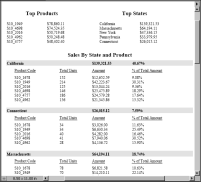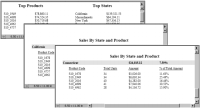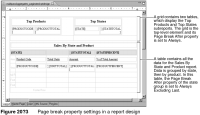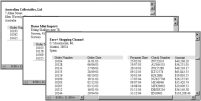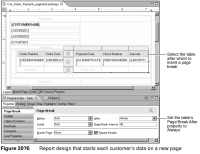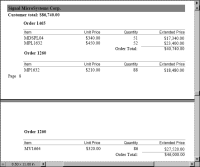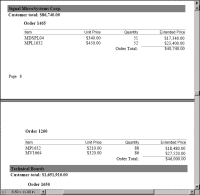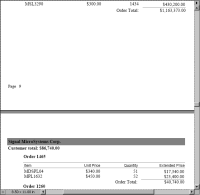Inserting page breaks
Reports that consist of a series of documents or distinct sections typically look more organized if each document or section appears on a separate page. For example, if a report consists of a cover letter, disclaimer information, and a summary report that is followed by a detailed report, you can insert page breaks to display each type of information on a separate page. Similarly, if a report groups sales data by state, then by customer, you can start the data for each state on a new page.
You can specify page breaks for the following elements:

Top-level elements. These are elements that are not placed within another element.

Second-level elements. These are elements that are placed in a top-level list, table, or grid. For example, if table A contains table B, and table B contains table C, you can specify a page break for table A and table B, but not for table C.

Groups. You can specify page breaks for data groups defined in top-level and second-level tables or lists.

Grid rows and detail rows in tables.
Specify page breaks using the Page Break Before and Page Break After properties.
Table 20‑1 describes the values you can select for these properties.
Table 20‑1 Values for Page Break Before and After properties
Page Break Before,
Page Break After value | Description |
Always | Always insert a page break before or after the selected element. |
Auto | Insert a page break before or after the element as necessary. Auto is the default value. |
Avoid | Avoid inserting a page break before or after the selected element. |
Always Excluding First | Applies only to groups and Page Break Before. Always insert a page break before each instance of the selected group, but not before the first instance. |
Always Excluding Last | Applies only to groups and Page Break After. Always insert a page break after each instance of the selected group, but not after the last instance. |
The rest of this section provides examples of inserting page breaks for various elements. For simplicity, the examples of the generated reports shown in this section are in PDF format. The other output formats that support pagination show similar results.
Inserting page breaks in a report with multiple sections and groups
Figure 20‑1 shows a PDF report with default page breaks. In this report, the page break properties are set to Auto.
Figure 20‑2 shows the same report with page breaks after the Top Products and Top States reports and after each state group in the Sales By State and Product report. Notice in
Figure 20‑2 that the title, Sales By State and Product, repeats at the top of every page of that report. The Repeat Header option is set by default. To display the report header only once, at the beginning of the report, deselect the Repeat Header option.
Figure 20‑1 PDF report using default pagination
Figure 20‑2 PDF report using custom pagination
Figure 20‑3 shows the report design and indicates where and how page breaks are set. In this report design, page breaks are set as follows:

The Page Break After property of the grid at the top of the report is set to Always, which inserts a page break after the grid. Alternatively, selecting the top-level table element that appears after the grid and setting its Page Break Before property to Always achieves the same result.

The Page Break After property of the state group is set to Always Excluding Last. This setting inserts a page break after each state group, except for the last group. If the Page Break After property is set to Always, the report displays a blank page after the last group. Alternatively, set the state group’s Page Break Before property to Always Excluding First. This setting inserts a page break before each state group, except for the first group, and prevents a blank page from appearing before the first group.
Figure 20‑4 shows a partial view of the group editor where you set the state group’s Page Break After property.
Figure 20‑4 Page break properties for a group
Inserting page breaks in a master-detail report
In the next example, a report displays data with a master-detail relationship. An outer, top-level table contains two inner tables. The top-level table displays customer information. For each customer, the inner tables display order information and payment information, respectively.
Figure 20‑5 shows the PDF report that is paginated so that each customer’s information starts on a new page.
Figure 20‑5 PDF output starting each customer’s data on a new page
Figure 20‑6 shows the report design and indicates where and how the page break is set. The Page Break After property of the second-level table is set to Always.
Avoiding page breaks in a section
In addition to specifying where page breaks occur, you can also specify that contents of a particular report section stay on the same page, when possible.
Figure 20‑7 shows a portion of a PDF report that groups items sold by order number and by customer. The figure shows the detail rows for an order split onto two pages.
Figure 20‑7 Detail rows of an order appear on two pages
You can keep the order details together by setting the Page Break Inside property of the orders group to Avoid, as shown in
Figure 20‑8.
Figure 20‑8 Page Break Inside set to Avoid for orders group
Figure 20‑9 shows the results of setting the Page Break Inside property of the orders group to Avoid. All the detail rows for the order appear on the same page. To keep the rows together, BIRT starts the order on a new page.
Figure 20‑9 Detail rows that were previously split appear on the same page
To keep all the orders for each customer together, set the customer group’s Page Break Inside property to Avoid.
Figure 20‑10 shows the results of setting the Page Break Inside property of the customers group to Avoid. The data for each customer stays together on the same page. If the data for a customer does not fit in the remaining space on a page, the customer record starts on a new page.
Setting an element’s Page Break Inside property to Avoid does not guarantee that the contents of the section always appears on the same page. If the contents of a section exceed one page, the content has to appear on more than one page.
Use Page Break Inside sparingly. Computing where data should appear and where to insert page breaks is resource intensive. In addition, if some sections contain a lot of data, the pages of the generated report are likely to display a lot of white space at the bottom, as the PDF report in
Figure 20‑10 shows.
Figure 20‑10 Customer data that was previously split appears on the same page
